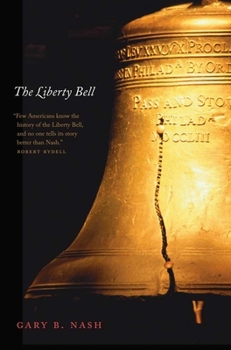Book Overview
Each year, more than two million visitors line up near Philadelphia's Independence Hall and wait to gaze upon a flawed mass of metal forged more than two and a half centuries ago. Since its original casting in England in 1751, the Liberty Bell has survived a precarious journey on the road to becoming a symbol of the American identity, and in this masterful work, Gary B. Nash reveals how and why this voiceless bell continues to speak such volumes about...
Format:Paperback
Language:English
ISBN:0300171420
ISBN13:9780300171426
Release Date:February 2011
Publisher:Yale University Press
Length:256 Pages
Weight:0.65 lbs.
Dimensions:0.7" x 5.3" x 8.0"
Customer Reviews
2 ratings
An Appealing History of a National Symbol
Published by Thriftbooks.com User , 13 years ago
Our national symbol is and always will be our glorious flag, for which soldiers say they will fight and die and to which millions of children recite a reverent pledge every school day. We have other symbols, like Uncle Sam or the eagle. And then there is the Liberty Bell. "As icons go," writes Gary B. Nash in _The Liberty Bell_ (Yale University Press), "there's nothing quite like it short of the Rosetta Stone or the Holy Grail." Nash is a professor of history, and he has written a lot about the most recent use of the bell and its surrounding exhibition areas. That "use of the bell" deserves explanation; the bell no longer produces auditory peals, and hasn't rung properly since it developed its famous crack. But even the silent bell has stood for a surprising number of causes (besides for just the USA), and it is visited by a million and a half Americans and others who want to be in its presence, and sometimes shed a few tears there. The bell wasn't always so special an item; it was at one point nearly scrapped for junk. It had its first official duties in 1753, in the standard use of ringing to convene the legislative assembly. In 1761 it rang to celebrate the accession to the throne of George III, but it rang, too, in 1765 to warn that English ships were coming to deliver stamps used in the Stamp Act. It was to ring many times in this sort of protest, culminating on 8 July 1776. Note that date; within the bell's very State House, the Declaration of Independence had been signed on 4 July; newspapers printed it on 6 July; and the bell rang for its first public reading on 8 July. The bell was unable to do its primary job after it got cracked, but for the next century it was tapped in celebration by those wielding rubber mallets and producing dull thuds. With its "Proclaim Liberty" inscription, it rang loudly as a symbol of abolition. Indeed, around this time it became known not as the "Old Bell," but as the Liberty Bell, and it was pictured in abolitionist handbills and poems. Around this time, too, sentimental stories circulated of how the bell joyously rang for the signing of the Declaration; it never happened, but what difference did that make to real patriots? After the Civil War, the bell could be seen as a symbol of reconciliation; Jefferson Davis himself bowed in reverence to it in Biloxi when it made one of its many trips out of Philadelphia in 1885. When it was at the Columbian Exposition in Chicago in 1893, John Philip Sousa debuted his "Liberty Bell March," which is nowadays better known as the theme from Monty Python. Every time the bell went on the road, however, it came back lighter, for people wanted just a little chip of it as a keepsake. After a cross-country trip in 1915, it was home in Philadelphia to stay. In 1958, a whisky company paid for a miniature reproduction of the bell to be shown at the World's Fair in Brussels, and the _Observer_ said of it, "As a symbol of freedom and the rights of man - it's a s
A ton of liberty
Published by Thriftbooks.com User , 13 years ago
This 217 page book is part of an interesting `Icons of History series`. Although many would make a case for the Statue of Liberty being the icon of liberty, Gary Nash builds a detailed case for the liberty bell being the supreme icon. There are illustrations throughout the book that show its' history; from the casting by the White Chapel foundry in England through the 2 recastings done in the States. The many accounts, both true and legend are told, from the first tolling for the reading of the Declaration on July 8, 1776, to the hiding of the bell from the British during the war, so that it would not be melted down for cannon balls and shot, through the travels the bell made across the country for exhibits. The years of neglect and the visits of foreign dignitaries, such as Lafayette's that spurred the beginnings of the reverence for this symbol of national pride. There are comparisons and tales of the people that the liberty bell did not ring for; African Americans and women. The history of protests and ceremonies are all here including the use of its' name and image for advertising and patriotic purposes. The liberty bell could still be touched by visitors into the 1990's, but now it resides in the Liberty Bell Center since 2003. The decision making for that center and the area around Independence Hall are also described. This is a book for students and lovers of history and those wishing to learn more about this special icon of liberty.





